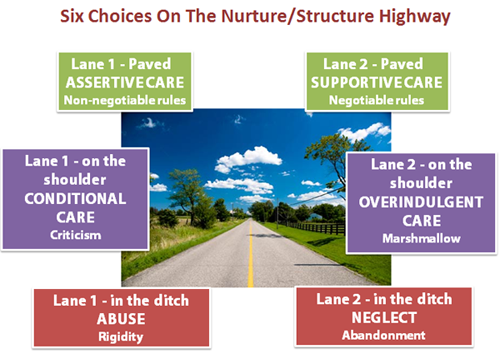Balancing Nurture and Structure in Your Relationship with Your Child
As a parent, you’ve probably come across the idea that we all have a “style” of parenting—a way we tend to approach this most challenging of jobs. You’ve probably heard of the “permissive,” “authoritarian,” and “authoritative” parenting styles. Many years ago, I came across the book Growing Up Again, by Jean Illsley Clarke and Connie Dawson, that changed the way I think about this issue of “parenting styles.” Based on Jean Clarke’s research at the University of Minnesota, it describes a different way of thinking about this that I want to share with you here.
Rather than talking about “parenting styles,” Clarke and Dawson explore two aspects of how we parent our children: how we provide nurture and how we provide structure. Nurture is how we care for our children and foster their development. Structure is how we set boundaries and rules and the relationship framework we use. Within these two aspects, they explore which parenting behaviors are helpful and which are hurtful to children. What I like about their model is that it’s flexible, realistic, and culturally sensitive. It recognizes that all parents use different approaches at different times depending on their child’s age and current circumstances.
They came up with what I think is a brilliant image to describe all the possibilities: The Developmental Parenting Highway. Think about a nice country road — two paved lanes of smooth riding that easily gets you to where you want to go.
On both sides of the road are the shoulders, rough and bumpy. Beyond the shoulders are the two ditches that can cause quite a bit of damage to people and require a “tow truck” if you end up there.
Clarke and Dawson use this metaphor to describe six approaches parents may use in response to a child’s need for nurture and structure.
- One paved lane represents an Assertive approach to providing nurture. The parents provide care without asking their child’s opinion or getting his or her permission. They take the lead in deciding what the child needs and then meet the need. This approach uses “Non-negotiable Rules” to create structure for the child. An example would be telling a child it’s time to put on his coat to go outside in the cold, windy air—without asking if he wants to wear a coat. The child is expected to follow the rules, although the rules can be modified as circumstances change. In Lane #1, the adult’s interaction with the child is warm and age-appropriate, communication is positive, and discipline is clear and fair.
- The other paved lane represents a Supportive approach to providing nurture. The parent offers care by saying, “Do you want help or want to do that yourself?” The help can be accepted, declined, or negotiated. This approach uses Negotiable Rules to create structure for the child. An example would be a 5-year old’s attempt to tie her own shoe. The parent, knowing that some 5-year-olds can tie their own shoes, asks the child if she wants help or waits for her to ask for help. The child has a voice; her opinion is heard. This fosters independent thinking and problem-solving. In Lane #2, the adult’s interaction with the child is warm and age-appropriate, communication is positive, and discipline is clear and fair.
- Next to the Assertive paved lane is the shoulder that represents a Conditional approach to providing nurture. Parents will provide nurture if the child meets their expectations. “I’ll approve of you if…you make me look good/are a good boy/get good grades/stop being so full of energy.” This approach uses Criticism to create structure for the child. An example would be the parent who responds to a child who is running in the aisles of the grocery store by saying, “You never listen to me. Why can’t you be like your sister who walks quietly with me? What will people think? …” The child is subjected to discouraging words, sarcasm, and ridicule. On this shoulder, there are often too many expectations and too much discipline. Warmth and communication are inconsistent.
- Next to the Supportive paved lane is the shoulder that represents an Overindulgent approach to providing nurture. The parent provides too much, too soon, and too long. The parent does things for the child he should do for himself, and few limits are set. Often, the parent, motivated by wanting the child to like him or her, can be invasive. This approach uses a structure like a Marshmallow, in which the parent easily gives in, overindulges, and offers too few expectations and too little discipline. An example would be the parent whose child is nagging for a treat at the store and, after saying “no” three times, says, “Well, OK, just stop whining at me.” This parent also easily fails to set in advance expectations about behavior. On this shoulder, there are often too few expectations and too little discipline. Warmth and communication are inconsistent.
- Next to the Conditional shoulder is the ditch of Abuse. Here, the parent uses physical harm to control the child—including shaking, hitting, or sexual touching—as well as emotional harm, such as pervasive yelling, shame, extreme ridicule, and demeaning words. There is an absence of nurture. This approach uses a structure of Rigidity that ignores the developmental needs of the child. The rules are unchanging, even if circumstances change. Expectations and discipline are extremely high. In addition, the rigid structure can serve to satisfy the parent’s desire for absolute control. It’s “my way or the highway.”
- Next to the Overindulgent shoulder is the ditch of Neglect. Here is the parent who doesn’t notice or meet the child’s needs, the parent too busy satisfying her own needs or struggling to cope with life and becoming physically and/or emotionally absent. “Don’t bother me” is what the child hears In the absence of structure is Abandonment. Expectations and discipline are absent.
Here is a picture of the Developmental Parenting Highway:
 |
| Photo: iStockphoto/Thinkstock |
When you’re on the highway, think about the situations with your child when an Assertive approach is called for or when a Supportive relationship would be best: When do I need to take charge? When can my child do more for herself? What is my way of giving Assertive and Supportive care? Do I like the balance I use between them? What would I like to change?
Ask yourself, what are my Non-Negotiable Rules and which are Negotiable? Why do I have the rules I do? Have these been made clear to my child? Does he know why some are flexible and some are not? Do I like the balance I use between the two? What would I like to change?
Thinking about parenting in this way will develop mindfulness and awareness. If you can’t remember all the parts, come back to the image of the highway and remember that there are two helpful ways to nurture your child and provide structure: one in which you take charge and one in which your child can have more say. Having these two helpful options will give you the flexibility you need to find your way with each child, at each age, and for each situation.

